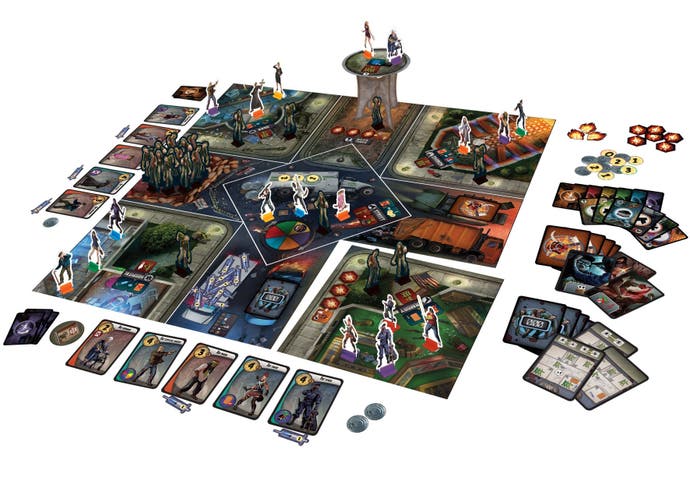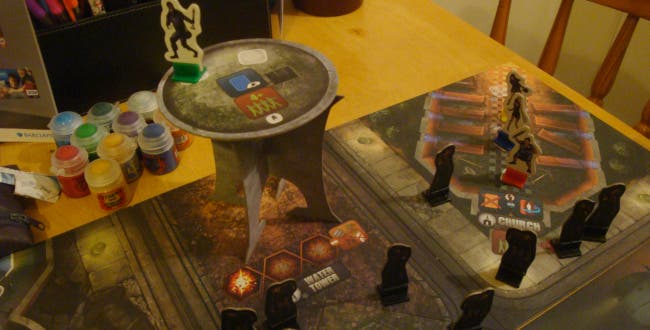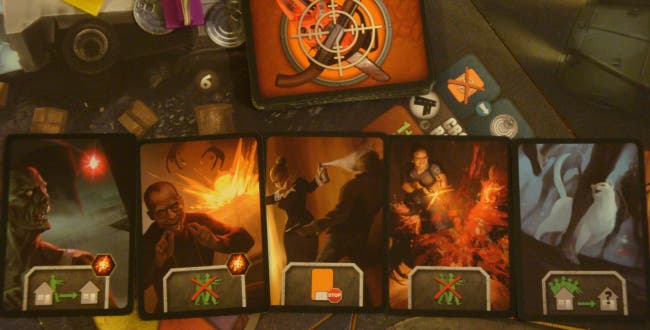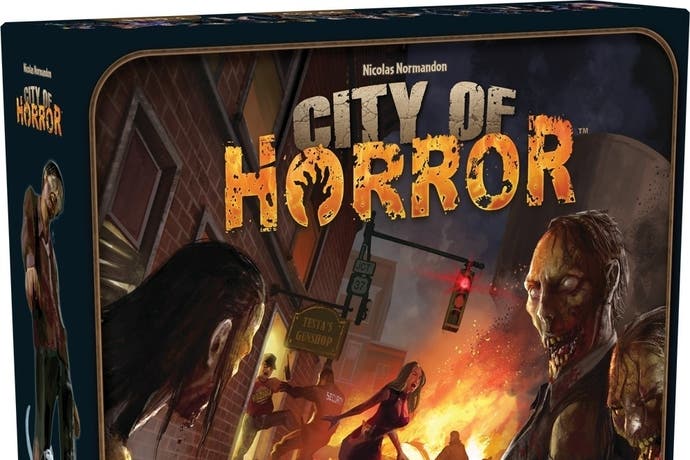City of Horror review
The talking dead.
When Eurogamer asked me to start doing board game reviews, I had no idea where to start after video game licenses. The Board Game Geek database holds 62,000 games. Where the hell to begin?
So let's begin with hell.
Zombie video games usually miss the point of zombie fiction. The point isn't the brightness of human nature in a crisis, but the darkness. City of Horror, then, offers its three to six players the best zombie game since DayZ.
City of Horror sees everyone trying to shepherd a personal handful of survivors - your people - through just four hours in a 28 Days Later-type zombie apocalypse. And you're going to make a terrible, disgusting, amoral mess of it, because this isn't Left 4 Dead. City of Horror has no safe rooms, no heroes and no hope. It does have a couple of guns... but you won't be using them on the zombies.

Here's the problem. City of Horror has five buildings - the church, bank, gun shop, hospital and water tower - and at the start of the game everyone's survivors are scattered throughout. Your Burglar, say, ends up in the church with your friend's Businesswoman and his girlfriend's Chef.
Every turn (each representing an in-game hour), more zombies are added to every building. But you're OK. You're fine. At the start of the game, everyone gets a secret hand of one-shot cards to help them manage the zombies, including that church. "We're OK. It's fine," you say, your Burglar using a molotov cocktail card to blow up some zombies, buying you another hour. Phew. You're the table's hero!
A question, then: how do you react when someone then fires a flare gun out of the window of the hospital, luring some of its zombies away... and back over to the church? Suddenly, you're overrun again. "You son of a bitch!" you cry, hurt. But this player excuses themselves. They have no weapon cards, they say, and they explain that you should be grateful that they didn't trip your building's fire alarm instead. Are they lying? Should you forgive them? How do you react?
Congratulations. You are now playing City of Horror, where this reshuffling of zombies can be compared to the world's most horrible game of musical chairs. Eventually, though, the music stops, and the survivors in an overrun building have one means of saving themselves.

They have to feed the zombies a survivor.
One player is going to have a survivor bundled out of the building like terrified post through Hell's own letterbox. You'll argue. You'll plead. You'll use cards, trade cards, trade food, or even the precious plague vaccine tokens that are like cardboard gold. Bartering your options, your very hope, away.
Then the vote occurs, always taking the form of an excellently theatrical "3, 2, 1...", before everyone points simultaneously at who they want to shove outside. Of course, none of those agreements you just made are binding. Again: how are you going to react when you hand your own, real-life brother a vaccine and he pockets it, only to vote for you anyway, playing you for a sucker?
I'll tell you what you'll do. You'll stare at the board, like a disassembled gun, and try to figure out how to murder him.
Really, the discussion and voting at the heart of City of Horror is the biggest reason I chose it, even over that accessible zombie theme or the fact that it's just an amazing game. I picked it because it plays to one of the strengths of board games as a platform over video games, which is talking. Here's an entire genre of gaming that video games have left unexplored - but more than that, it makes use of the best, most surprising, most powerful component at any board game's disposal - the friends or family sat opposite you.
When people imagine board gaming, thoughts of Chess or Cluedo rise to the surface of their minds like scum on bathwater: games spent staring down at a board. City of Horror is, in part, such a dramatic experience because you play it looking up at your friends. It's personal. And because it's personal and so much fun, you'll be laughing almost as much as you're panicking.

Here are just a few highlights from my first ever game of City of Horror: a Priest pushing my Teenager out of a water tower. My Burglar dashing for the bank, only for another player to lock the door, leaving him marooned in the board's central crossroads like an ambulatory kebab. Two players threatening one another, both trying to sound intimidating, collapsing the rest of the table into hysterics because they're arguing about the fate of a two-dimensional cardboard chef.
As a game, it's partly so emotive and exciting because of the binary nature of success. There is no slow amassing of points, no chipping away at some greater task. There's just one of your guys getting eaten, or you giggling outrageously as someone else gets eaten. Every second of every turn, there's only one question: "ARE YOUR BALLS IN A FIRE Y/N". If they are, you're terrified. If they're not, you're laughing.
Every clean corner of City of Horror's design fosters tension and talking, ultimately powering the game, making it thrum to life on your kitchen table. We've already mentioned the secret cards that both represent a dwindling resource (tension) and engender love and hate (talking), but they can also be played at any time at all, switching up the puzzle (tension) and enabling them to take a role as you canvass your friends for votes (talking).
But this game's not done. Your dwindling options and your desperate dialogues are drawn out by a final pit-stop. Every survivor card is actually double-sided, and you can flip it - once - to use that character's power. The kid can hide. The burglar can break into a building that's full. The pregnant woman gives birth, giving her two votes. But if you do use these, those survivors are worth fewer points at the end of the game.

Well, most of the survivors have a one shot power. The two most valuable survivors, Grandpa and The Blonde, are actually hobbled. Gramps is too befuddled to vote, but can be temporarily roused from his medicated stupor to vote once. The Blonde does nothing. At all. Good luck with that!
But we're still not done. Players in the board's three-dimensional water tower can see where zombies will arrive, and can share or not share this information (tension) or lie (talking). There's also the risk that buildings can collapse if players use too many explosives.
But I don't want to get too focused on the fact that this game is inventive, or that its talking feels so fresh, like you're flexing muscles you never knew you had. It's just that there's so much fun packed into its box.
City of Horror speaks of everything amazing about board games right now. You're paying for a set of gorgeous components, and for a game that is not only terrifying, riveting and hilarious, but elegantly tucked up in a thin pamphlet of rules simple enough for kids to understand. If you're OK with your kids coming to the utilitarian conclusion that such and such has to die, that is. But for all of City of Horror's bleakness, given the current state of video games, it's awfully nice to be given a choice.

